Some people are puzzled with the terms pre-existing or preexisting. Well, both forms exist, but is one more correct than the other? This article will clarify the differences between these two terms regarding their meanings, usage, and contexts.
The compound words involved, the style guides, and the assurance of clarity and readability will also become the subject of discussion. By the time you finish reading this article, you will better understand where pre-existing comes from and when to use one or the other in your context.
Why is there Confusion?
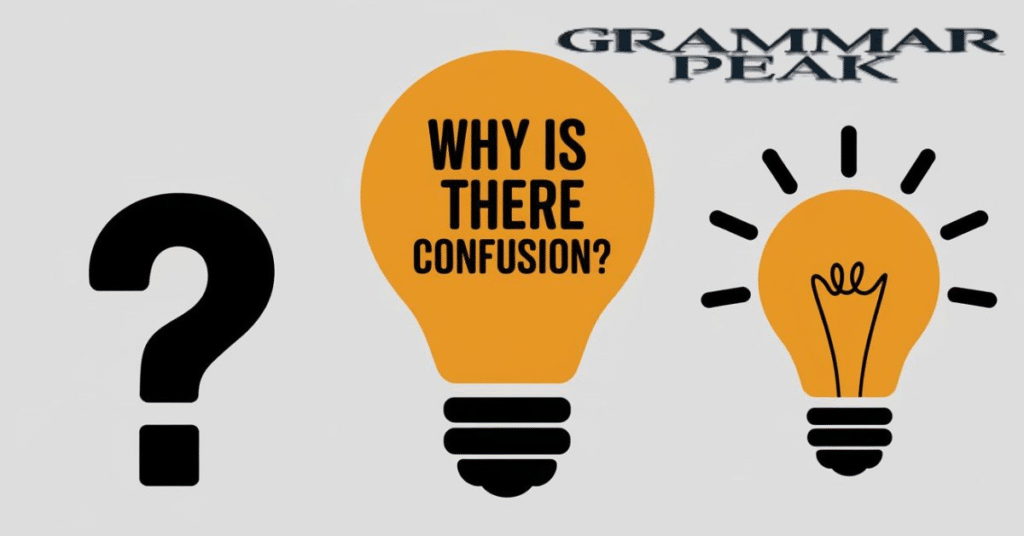
The confusion surrounding pre-existing and preexisting stems from several factors. First, both terms sound the same when spoken, making it easy to overlook the difference in writing. Additionally, the history of compound words shows that language evolves.
Over time, many hyphenated words have transitioned to closed forms, leading to different writing preferences. Furthermore, the prefix “pre-“ means “before,” which can complicate matters. Many words using this prefix can be hyphenated or closed, depending on their usage. For example, “pre-arranged” and “prearranged” are both correct.
You will like Pre-Existing or Preexisting: Which One is Correct?
What do ‘Pre-Existing’ or ‘Preexisting’ Mean?

To understand the difference between pre-existing and preexisting, we must first examine their meanings. Pre-existing generally refers to conditions or situations that existed before a certain point in time.
For example, a pre-existing condition in health insurance refers to a medical issue that existed before a person’s policy began. On the other hand, preexisting can carry a similar meaning but is often used in a broader context. It can refer to any existing situation before a specific event, not just in a medical sense.
“Pre-Existing” or “Preexisting”: Which One Should Be Used?
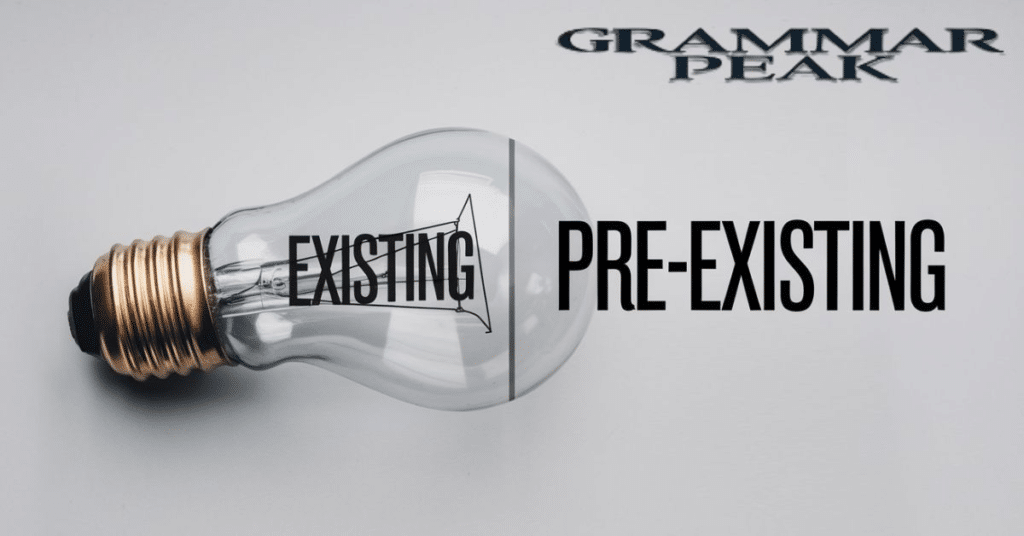
Choosing between “pre-existing” or “preexisting” depends on various factors. In formal writing, the hyphenated form is typically preferred. This is especially true in fields like law and medicine, where clarity is critical.
Style Guides and Consistency
The importance of style guides cannot be overstated when it comes to choosing between pre-existing and preexisting. These guides help writers maintain consistency, which is essential for effective communication.
- The Chicago Manual of Style generally prefers the hyphenated form, pre-existing, for clarity, especially in specific contexts.
- The choice between pre-existing and pree xisting can depend on the style guide you’re following, with some guides favoring the hyphenated form and others the closed compound.
- In more formal contexts, such as legal documents, medical texts, and academic writing, the hyphenated form, pre-existing, is often used.
- The terms pre-existing and pree xisting are often used interchangeably, but the choice between them should be guided by the style guide you’re following the context, and audience expectations.
Readability and Clarity
Readability and clarity are essential components of effective communication. Using pre-existing or preexisting correctly can enhance both.
- Whether you use pre-existing or pree xisting can depend on the style guide you follow, with some preferring the hyphenated form and others the closed compound.
- The term pre-existing or pree xisting is often used in health insurance to describe conditions that were present before coverage began.
- It’s important to understand the implications of pre-existing or pree xisting conditions when choosing a health insurance plan.
- The choice between pre-existing or preex isting can also impact the SEO of your content, affecting its searchability and relevance.
- Both pre-existing and pree xisting refer to something that existed at an earlier time, but their usage can vary depending on the context.
- The clarity in your writing can be enhanced by using pre-existing or pree xisting correctly.
- Disclosing any pre-existing or pree xisting health issues is crucial when applying for health insurance.
- The debate between pre-existing and preexisting highlights the importance of precision in language use for effective communication.
Audience and Context
Understanding your audience and context is critical when deciding between pre-existing and preexisting. Different audiences may have varying levels of familiarity with the terms.
- The choice between pre-existing and preexisting in your writing can make a significant difference, depending on your audience’s familiarity with the terms.
- When discussing health insurance, your audience may have a better understanding of the term pre-existing, while preexisting could be more suitable in less formal contexts.
- It’s important to consider whether pre-existing or preexisting would be most readily understood by your audience.
- The use of pre-existing and preexisting in medical literature may differ, reflecting different audiences and contexts.
- A clear understanding of pre-existing and preexisting is essential when discussing health policy, as these terms can impact perceptions and understanding.
- The terms pre-existing and preexisting are often used interchangeably, but audience understanding and context should guide your choice.
- The distinction between pre-existing and preexisting can seem minor, but in certain contexts, it can significantly impact clarity and comprehension.
- Whether to use pre-existing or preexisting in your writing can depend on the audience’s familiarity, the context, and the specific style guide you’re following.
Must Be Read Pre-Existing or Preexisting: Which One is Correct?
Origins of the Word “Pre-Existing” or “Preexisting”

The origins of the word “pre-existing” or “preexisting” are rooted in the evolution of language. The prefix “pre-” derives from Latin and means “before.” Over time, compound words have evolved, with many transitioning from hyphenated forms to closed compounds.
This evolution reflects changing modern language trends and influences how we communicate today. Historically, the use of hyphens has served to clarify meaning. However, as language evolves, many words have become accepted in their closed forms. This change may lead to confusion, especially for those accustomed to traditional usage.
| Origin | Description |
| Etymology | The term “pre-existing” or “preexisting” originated in the 1590s as a present-participle adjective from “pre-exist”. The prefix “pre-” means “before,” and “exist” signifies something that exists beforehand. |
| Related Terms | The term “pre-exist” is related to “pre-existing” and “preexisting.” It means “to have actual being of any kind, actually be at a certain moment or throughout a certain period,” and it originated around 1600, from French “exister” (17th century), from Latin “existence/existence” which means “to step out, stand forth, emerge, appear; exist, be”. |
| Usage | The terms “pre-existing” and “preexisting” are often used in medical insurance to refer to conditions that existed before the coverage period. They are also used in various other contexts to denote something that existed or occurred previously. |
| Hyphenation | Originally, compound words like “pre-existing” were typically hyphenated, but over time, usage has varied between the hyphenated and closed forms. |
Examples in Context
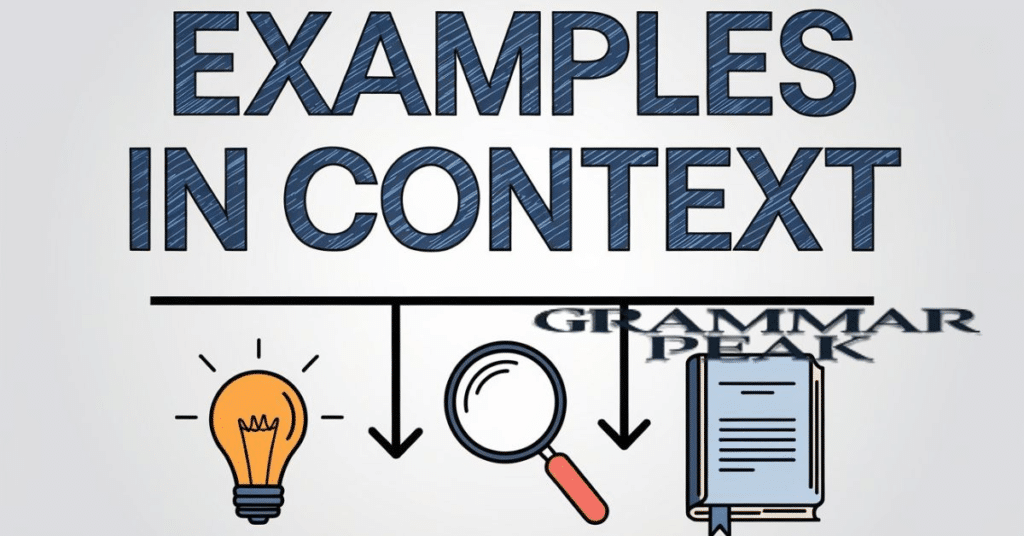
pre-existing
- A pre-existing condition can affect your eligibility for certain medical insurance plans.
- It is essential to disclose any pre-existing conditions when applying for health coverage.
- Many people are unaware of how pre-existing conditions can influence their healthcare options.
- The pre-existing clause in the insurance contract outlines what conditions are covered.
- Understanding the implications of pre-existing health issues is vital for patients seeking treatment.
- Some insurance policies may exclude coverage for pre-existing conditions for a specified time.
- It’s important to read the fine print regarding pre-existing conditions in any insurance policy.
- Many patients with pre-existing conditions feel frustrated by the limitations of their insurance plans.
preexisting
- The term preexisting is often used in health insurance to describe conditions that were present before coverage began.
- Individuals with preexisting conditions may face higher premiums or limited coverage options.
- Applicants must disclose any preexisting health issues to their insurance providers.
- Many people are concerned about how preexisting conditions will affect their access to healthcare.
- Healthcare reform has aimed to address the challenges associated with preexisting conditions.
- The preexisting condition clause in some policies can lead to confusion among consumers.
- Understanding your rights regarding preexisting conditions can empower you when choosing a health plan.
- In recent years, there has been a growing emphasis on protecting individuals with preexisting conditions in healthcare legislation.
| Context | Preferred Term |
| Medical literature | Pre-existing |
| Legal documents | Pre-existing |
| Informal writing | Preexisting |
| Academic writing | Pre-existing |
| Casual conversation | Preexisting |
Using these examples, writers can navigate the complexities of choosing the correct form based on context.
Synonyms for “Pre-Existing” or “Preexisting”
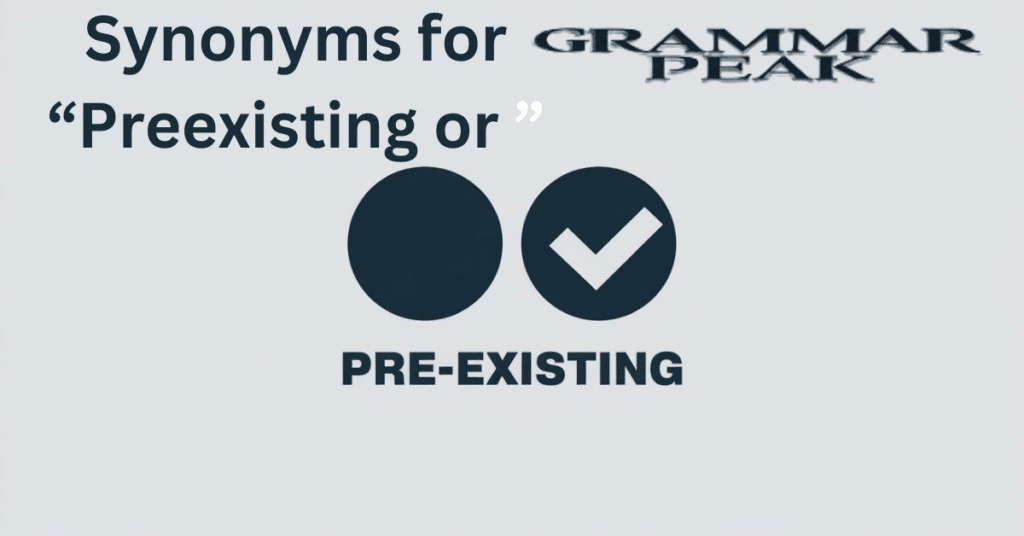
Lastly, exploring synonyms for “pre-existing” or “preexisting” can enhance your vocabulary and writing skills. Here are some synonyms for each term:
For pre-existing:
- Foregoing
- Preceding
- Previous
- Earlier
- Former
- Antecedent
- Preexistent
- Established
- Prior
- Anterior
- Initial
For preexisting:
- Previous
- Precedent
- Initial
- Preceding
- Original
- Prior
- Early
- Premature
- Former
- Foregoing
- Antecedent
- Pre-existent
FAQ” S
What is the difference between “pre-existing” and “preexisting”?
The difference lies in their form; “pre-existing” is hyphenated, while “preexisting” is a closed compound word.
When should I use “pre-existing”?
Use “pre-existing” in formal writing, especially in legal and medical contexts.
Is “preexisting” acceptable in informal writing?
Yes, “preexisting” is often used in casual conversations and informal writing.
What does “pre-existing condition” mean?
A “pre-existing condition” refers to a health issue that existed before insurance coverage began.
Do both forms have the same meaning?
Yes, both “pre-existing” and “preexisting” generally convey the same meaning, but usage may vary with context.
Conclusion
Knowing whether to use “pre-existing” or “preexisting” is crucial for clear communication. While both terms can be correct, their usage often depends on context and audience. The hyphenated form is typically preferred in formal writing, particularly in medical and legal contexts, while the closed form may be suitable for informal writing. Ultimately, consistency in style and adherence to writing standards will enhance readability, ensuring that your message is easily understood. Choose wisely to maintain clarity and precision in your writing.

Mason Blake is an experienced blogger with a passion for language and communication. With years of expertise in crafting informative and engaging content, Mason shares valuable insights on grammar and writing. His clear, concise, and reader-friendly approach has earned him a loyal following, helping readers sharpen their language skills and master the art of effective communication.

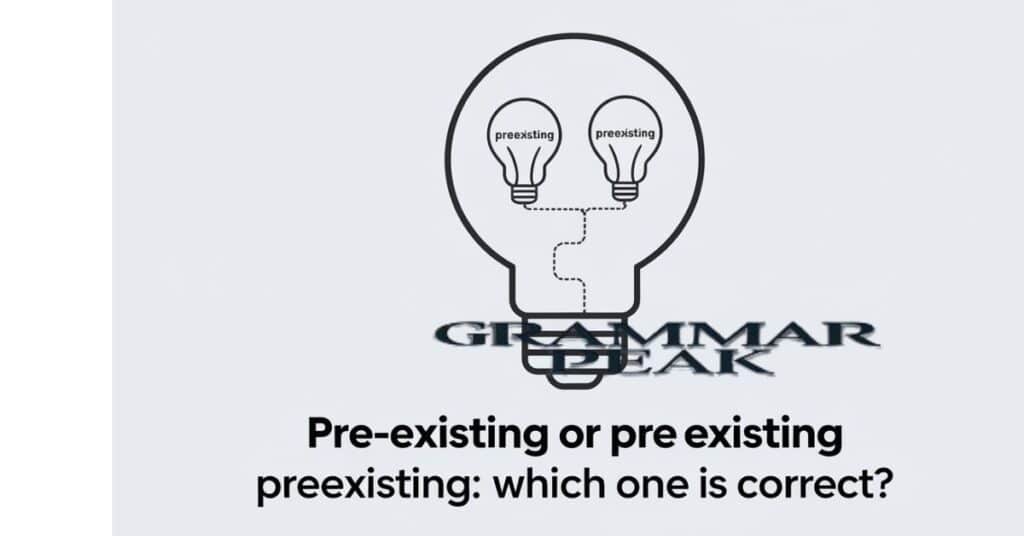






Thanks for sharing. I read many of your blog posts, cool, your blog is very good.
Thank you for your sharing. I am worried that I lack creative ideas. It is your article that makes me full of hope. Thank you. But, I have a question, can you help me?
I don’t think the title of your article matches the content lol. Just kidding, mainly because I had some doubts after reading the article.
Thanks for sharing. I read many of your blog posts, cool, your blog is very good.
Can you be more specific about the content of your article? After reading it, I still have some doubts. Hope you can help me.
I don’t think the title of your article matches the content lol. Just kidding, mainly because I had some doubts after reading the article.
Thank you for your sharing. I am worried that I lack creative ideas. It is your article that makes me full of hope. Thank you. But, I have a question, can you help me?
I don’t think the title of your article matches the content lol. Just kidding, mainly because I had some doubts after reading the article.
hello there and thank you on your info ?I抳e definitely picked up anything new from right here. I did on the other hand expertise a few technical points using this site, since I experienced to reload the web site many occasions prior to I could get it to load properly. I had been brooding about in case your web hosting is OK? Not that I’m complaining, but slow loading circumstances occasions will sometimes impact your placement in google and could harm your high-quality score if ads and ***********|advertising|advertising|advertising and *********** with Adwords. Well I抦 including this RSS to my e-mail and could glance out for a lot extra of your respective fascinating content. Ensure that you update this again very soon..
Superb post however , I was wanting to know if you could write a litte more on this subject? I’d be very grateful if you could elaborate a little bit further.
Immerse into the epic galaxy of EVE Online. Forge your empire today. Fight alongside thousands of players worldwide. Start playing for free
Thank you for being so generous with your knowledge.
It’s refreshing to find something that feels honest and genuinely useful. Thanks for sharing your knowledge in such a clear way.
Hi, i think that i saw you visited my weblog so i came to “return the favor”.I am trying to find things to enhance my site!I suppose its ok to use some of your ideas!!
Can you be more specific about the content of your article? After reading it, I still have some doubts. Hope you can help me.
You actually make it seem so easy with your presentation but I find this matter to be actually something that I think I would never understand. It seems too complex and very broad for me. I’m looking forward for your next post, I will try to get the hang of it! http://www.hairstylesvip.com
Great article! It really clarifies the subtle but important distinction between these two forms. This is especially relevant in contexts like medical and travel insurance documentation, where precision is key. I was recently reading about “pre-existing conditions” in the context of travel medical insurance for the USA, and it made me wonder: from a language precision standpoint, which form do major insurance providers tend to use in their official policy documents – the hyphenated “pre-existing” or the closed “preexisting”? Sorry for the link, but it’s to better illustrate the context I’m referring to: https://pillintrip.com/de/article/medical-insurance-for-usa-travelers-and-relocants-your-complete-protection-guide. Thanks for the insightful read!
Can you be more specific about the content of your article? After reading it, I still have some doubts. Hope you can help me. https://www.binance.info/fr-AF/register-person?ref=JHQQKNKN